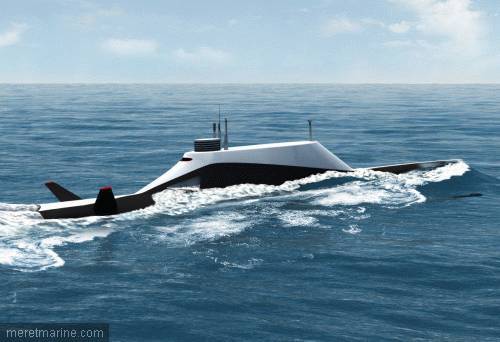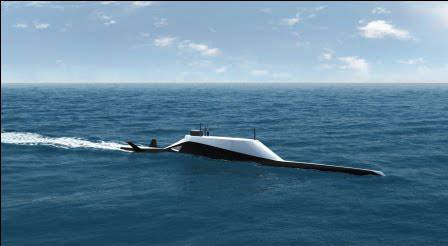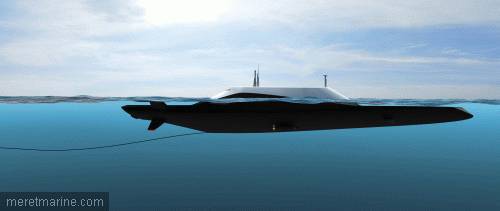Diving frigate
At the opening of October 25 in the Paris suburb of Le Bourget, the European naval salon EURONAVALE-2010 in Paris presents many projects of promising warships of the near future. Experts clearly identify two trends: the creation of anti-missile defense ships and ships specially designed for the basing of unmanned aerial vehicles. Among them there are both ordinary surface ships, and very futuristic projects like the SSX-25 “submersible frigate” proposed by the French concern DCNS.
The French themselves call the unusual ship “a submarine”: this is how the French name Sous-marin de surface can be translated into Russian. The ship with a length of 109 meters has a submerged underwater hull, optimized for high moves in the surface position. To do this, an especially powerful gas turbine is installed in the elongated knife-shaped hull of the ship, setting in motion three jet propulsion units, while the “surface submarine” will be able to pass an 38 node motion no less than 2000 nautical miles.
Turbines and diesel engines underwater course are located on a single basis in a massive deck superstructure. Upon arrival in the combat area, the ship makes a “dive”, partly turning into a submarine.
At the same time, the turbine air intakes and exhaust devices are closed with special valves, “snorkels” (air underwater powering devices of the diesel engines) are extended from the superstructure, azipods are in the center, and depth rudders are in the nose. In the submerged state, the ship's displacement is 4800 tons, it is able to move at speeds up to 10 nodes.
To observe the surface, a special retractable mast like a periscope can be used, equipped with a radar and various kinds of optical sensors.

The company does not indicate whether the ship is capable of operating in a fully submerged state, that is, without sliding devices for the intake of atmospheric air, only on an electric course. The company emphasizes that their diving ship to combat underwater targets is not optimized, however, it has eight torpedoes for self-defense in torpedo tubes.
The main armament of the ship - 16 universal vertical launchers to accommodate both cruise (including anti-ship) and anti-aircraft missiles.
Thus, as a promising ship, the French designers offer a certain hybrid of the frigate URO (high speed, seaworthiness, powerful missile system) and a strike submarine (stealth, ability to attack targets from a submerged position). The submerged hull will provide the hybrid ship with less vulnerability from rolling, making it a stable launch platform, and a developed superstructure will allow some of the submarine deficiency to be overcome. Moreover, a submerged body is also less visible in all ranges and is more economical due to less resistance to movement at the boundary of media.
In addition, according to experts, a developed superstructure allows you to place in it various fairly comfortable rooms for special forces and its specific equipment - an advantage that special-purpose submarines are deprived of. In the superstructure, of course, a special hangar for UAVs (unmanned aerial vehicles) can also be arranged, vertical take-off rotorcraft are especially attractive in this regard. Such helicoptersRobots can be stored in automated shelving on the sides of the hangar with a retractable roof that will open to release and receive UAVs.

Obviously, in such a configuration, the ship should be considered, first of all, as a scout, designed for secretive and long-term collection of information in any coastal area, for one reason or another not accessible to space or aviation intelligence. Another possible purpose of such a ship - clearing the bridgehead for commandos, stealth attacks on coastal targets, clearing the beaches before the arrival of the main landing forces. It is clear that he will be most valuable against the enemy who does not have modern means of anti-submarine warfare.
One should not think that the French invented something fundamentally new. Diving and semi-submersible submarines have been known since the last century, some of these ships were even used in combat. Thus, the British squadron class K ships of the First World War, equipped (due to the lack of powerful diesel engines) with steam turbine installations, were in fact diving ships and in combat operations operated from a semi-submerged position, hoping for protection of the hull by a water column. The well-known “Monitor” can also be considered a semi-submersible ship: the first self-propelled iron propeller artillery ship used by northerners during the American Civil War for shelling Hempleton raid.
You can also recall the German mini-submarines of the type "Seehund" and "Seeethefel": the first were an attempt to create some kind of sea counterpart of a single-seater fighter aircraft, and the second - a sabotage ship with the ability to go ashore using tracks.
Various projects of diving ships were created in the USSR. Those were actually the early Soviet submarines of the Pravda type. To achieve a high surface velocity, designer Andrei Asafov tried to inject the submarines of a squadron destroyer, the most high-speed surface ship at that time. But for destroyers, the ratio of length to width and width to draft is absolutely not peculiar to submarines. As a result, the ship was poorly controlled in the submerged state, and the high buoyancy margin extremely slowed the dive.

The design of the 1231 Dolphin diving torpedo boat also looked extremely original. The idea was personally presented by Nikita Khrushchev. While examining somehow at the naval base in Balaklava the speedboats of the TsKB-19 and TsKB-5 projects and observing the submarines based there, he suggested that in order to ensure covert actions fleet, which is especially important in conditions of atomic warfare, we must strive to "submerge" the fleet under water, and for starters we proposed to "submerge" a missile boat.
In accordance with the TTZ, the 1231 project ship was intended to launch surprise missile strikes against warships and transport in narrow places, on approaches to naval bases and enemy ports, to participate in the defense of the coast, fleet-based areas and coastal flanks of the ground forces, in repelling a landing assault forces and the disruption of the sea communications of the enemy, as well as for carrying hydroacoustic and radar patrols in places where the fleet is dispersed. It was assumed that when solving these problems, a group of such ships was to be deployed in a given area and for a long time to be in a submerged position at the waiting position or approach the enemy also in a submerged position, maintaining contact with him with hydroacoustic means.
Having approached, the rocket carriers floated up, at high speed they reached the line of the rocket volley, fired rockets, then again sank or broke away from the enemy with a maximum speed in the surface position. The presence of missile carriers in a submerged position and a high speed of attack during the attack should have reduced the time they spent under enemy fire, including means of air attack.
The project developed quite successfully from 1959 to the retirement of Khrushchev in 1964, when it was frozen and later closed.

The only application in which diving ships have justified themselves is high-speed semi-submersible amphibious boats, used, for example, by North Korean saboteurs, and for some time their Iranian counterparts. The same type of court, but already "self-made" is used by Colombian traffickers to deliver their goods to the United States. These are low-seating boats up to 25 meters in length, the surface part of the boats protrudes above the surface to a height of no more than 45 centimeters, they can take on board up to 10 tons of cocaine. The US military and law enforcement agencies call them self-propelled semi-submersible boats, Self-Propelled Semi-Submersibles (SPSS). Detection of such boats is extremely difficult, even for such a well-equipped service, as the US Coast Guard.
Apparently, this is what the French designers are guided by: some Somali pirates of a large semi-submersible or diving ship will most likely not really notice. But is it worth it? Is it possible that a ship of this class will be more expensive than a frigate and a submarine taken together, and in terms of efficiency it will be worse than each separately? It is clear that at the moment no one can answer this question, but still it seems that the future belongs to less exotic ships.

Information